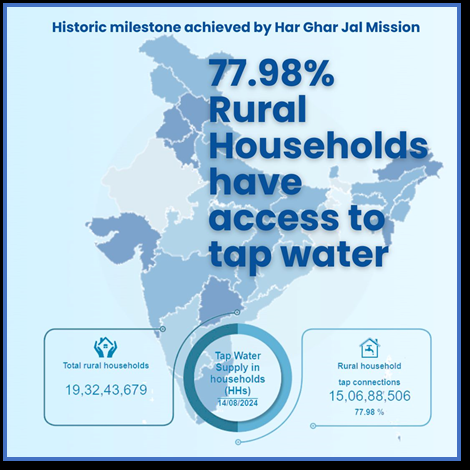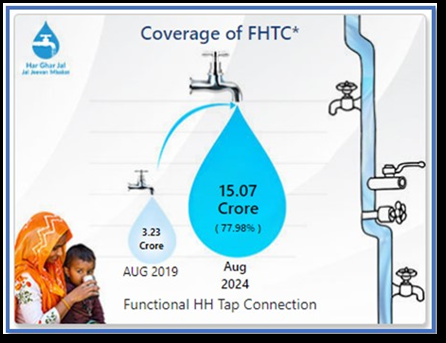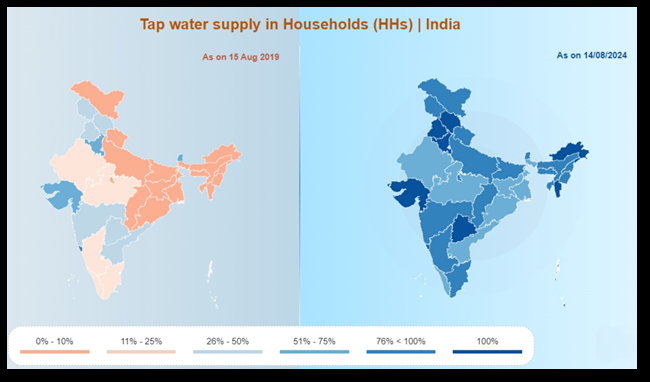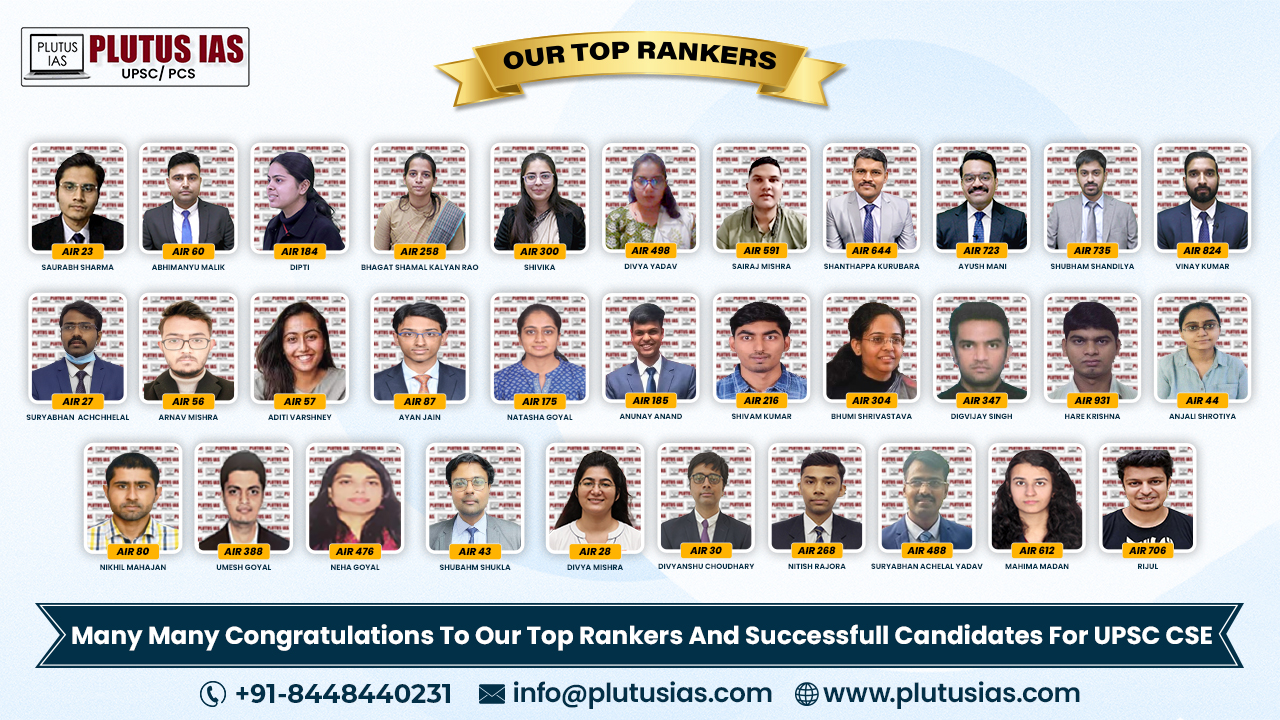13 Feb A Milestone in India’s Rural Water Revolution: Jal Jeevan Mission
SYLLABUS MAPPING:
GS-2-Social Issues- A Milestone in India’s Rural Water Revolution: Jal Jeevan Mission
FOR PRELIMS
What is the objective of the Jal Jeevan Mission?
FOR MAINS
Why in the news?

Key Achievements:
As of August 12, 2024, 11.82 crore additional rural households have been connected to tap water under the JJM, bringing the total to 15.07 crore households (77.98% of rural households).
This milestone significantly impacts rural populations by ensuring consistent access to potable water.
Objectives of the Jal Jeevan Mission
1. Provide tap water connections to every rural household.
2. Prioritize areas affected by poor water quality, drought, deserts, and villages under the Sansad Adarsh Gram Yojana (SAGY).
3. Provide tap water to essential public facilities, including schools, Anganwadi centres, health centres, and community buildings.
4. Monitor the functionality of tap connections to ensure consistent supply.
5. Encourage community participation (through cash, kind, or labour) to foster ownership of the project.
6. Ensure sustainability by maintaining water sources, infrastructure, and regular operational funding.
7. Empower the workforce in the water sector by training in various areas such as construction, plumbing, water quality management, and more.
8. Raise awareness about safe drinking water and promote shared responsibility among all stakeholders.
Components Under JJM:
1. Development of Infrastructure: Creating or upgrading in-village piped water supply systems to connect every rural household to reliable tap water.
2. Augmentation of Water Sources: Developing and enhancing reliable sources of water, such as wells, borewells, rivers, or reservoirs, to ensure a sustainable water supply in rural areas.
3. Bulk Water Treatment and Transfer: Establishing or improving water treatment plants and bulk water transfer systems to ensure that clean, safe water reaches villages, especially in areas where local sources are insufficient.
4. Technological Interventions for Contaminant Removal: Installing technologies in areas where water quality issues, such as contamination by arsenic, fluoride, or iron, affect the water supply. These technologies help ensure that water is potable and safe for consumption.
5. Retrofitting Existing Water Schemes: Upgrading and modifying ongoing or completed water supply schemes to ensure that every household receives at least 55 litres of water per capita per day (lpcd).
6. Greywater Management: Implementing systems to manage and recycle greywater (wastewater from baths, sinks, etc.), reducing water wastage and promoting sustainable water use practices within rural communities.
7. Flexi Funds for Unforeseen Challenges: Provision of Flexi Funds to address unforeseen challenges such as those arising from natural disasters, enabling timely and effective responses to safeguard the water supply.

Impact of JJM
1. Time-saving: The mission saves an estimated 5.5 crore hours daily, mostly for women who no longer need to spend hours fetching water from distant sources.
2. Health Improvements: By providing safe drinking water, JJM helps prevent 400,000 deaths annually due to waterborne diseases like diarrhoea, which is a leading cause of death in rural areas. The initiative is also projected to save 14 million Disability-Adjusted Life Years (DALYs), indicating a significant improvement in public health.
3. Reduction in Child Mortality: According to Nobel Laureate Prof. Michael Kremer’s research, safe water coverage can reduce child mortality among those under five by 30%, potentially saving 136,000 children’s lives every year.
4. Job Creation: JJM’s implementation is expected to generate 59.9 lakh person-years of direct employment during its capital expenditure phase. Additionally, 13.3 lakh person-years of direct employment will be generated during the operation and maintenance phase.

Challenges and Solutions in Jal Jeevan Mission (JJM):
| Challenges | Solutions |
|---|---|
| Lack of Reliable Water Sources | Financial assistance from the Ministry of Finance for infrastructure development. |
| Groundwater Contamination | Technological interventions like filtration systems (e.g., reverse osmosis) for safe drinking water. |
| Uneven Geographical Terrain | Decentralized water supply systems, such as solar-powered pumps and rainwater harvesting. |
| Scattered Rural Habitations | Bulk water transfer and decentralized systems for remote areas. |
| Regulatory Delays | Streamlined regulatory processes and coordination for faster statutory clearances. |
| Lack of Skilled Personnel | The Nal Jal Mitra Programme to train local personnel in water supply management. |
| Inefficient Implementation | Establishment of State and District Programme Management Units (PMUs) to monitor progress. |
Factors responsible for water scarcity in India:
1. Climate Change: Altered rainfall patterns and increasing frequency of droughts due to global warming affect water availability in many regions, particularly in arid and semi-arid areas.
2. Over-extraction of Groundwater: Over-reliance on groundwater for irrigation, drinking water, and industrial use has led to the depletion of aquifers in several parts of India, causing wells and borewells to dry up.
3. Pollution: Industrial and domestic waste contaminating rivers, lakes, and groundwater resources leads to reduced availability of clean and safe water for consumption.
4. Population Growth: Rapid population growth increases the demand for water, making it difficult to meet the needs of rural and urban areas alike, especially in water-scarce regions.
5. Agricultural Practices: Irrigation inefficiencies, such as flood irrigation and the overuse of water-intensive crops (e.g., rice, sugarcane), place immense pressure on available water resources.
6. Water Management Issues: Lack of proper water management and inefficient distribution networks result in wastage of water and unequal distribution across regions.
7. Deforestation: Deforestation and land degradation reduce the natural water retention capacity of the environment, leading to soil erosion, reduced groundwater recharge, and poor water retention in the ecosystem.
8. Limited Water Storage Infrastructure: Inadequate reservoirs, dams, and rainwater harvesting systems reduce the ability to store and manage water for future use, especially during dry seasons.
9. Urbanization: Rapid urban expansion increases the demand for water but often lacks proper planning and infrastructure for sustainable water supply and wastewater management.
Ways to ensure the sustainability of water sources for everyone:
1. Promote Water Conservation: Encourage water-saving practices like rainwater harvesting, reducing water wastage, and water-efficient appliances at homes, farms, and industries.
2. Implement Efficient Irrigation Techniques: Adopt drip irrigation, sprinkler systems, and crop selection suited to local water availability to reduce water usage in agriculture.
3. Protect Natural Water Bodies: Conserve rivers, lakes, and wetlands by preventing pollution and encroachment and implementing strict regulations to protect these vital water sources.
4. Increase Groundwater Recharge: Promote recharge pits, percolation tanks, and natural recharge systems to replenish groundwater levels and prevent over-extraction.
5. Water Recycling and Reuse: Encourage the reuse of wastewater for non-potable purposes (e.g., agriculture, landscaping) and establish systems for greywater recycling.
6. Reduce Pollution: Strengthen policies and enforcement on industrial effluent treatment, sewage management, and plastic waste reduction to prevent contamination of water sources.
7. Restore Watersheds and Forests: Protect and restore watershed areas and forests, which play a crucial role in maintaining the natural hydrological cycle and ensuring proper water flow.
8. Public Awareness and Education: Raise awareness about the importance of sustainable water use and conservation at the community level, through programs, campaigns, and educational initiatives.
Download Plutus IAS Current Affairs (Eng) 13th Feb 2025
Conclusion:
The Jal Jeevan Mission is a transformative initiative aimed at ensuring that every rural household in India has access to safe and reliable tap water by 2024. With significant progress already made, the mission is poised to improve the health, education, and socio-economic conditions of rural communities across the country while also promoting sustainable water management practices.
Prelims Questions:
Q. With reference to the Jal Jeevan Mission, consider the following statements:
1. The mission aims to provide clean tap water to every rural household in India by 2024.
2. As of August 2024, the Jal Jeevan Mission has connected 11.82 crore rural households to tap water.
3. The mission exclusively focuses on urban areas to ensure reliable water supply.
How many of the above-given statements are correct?
A. Only one
B. Only two
C. All three
D. None
Answer: A
Mains Questions:
(250 words, 15 marks)




No Comments